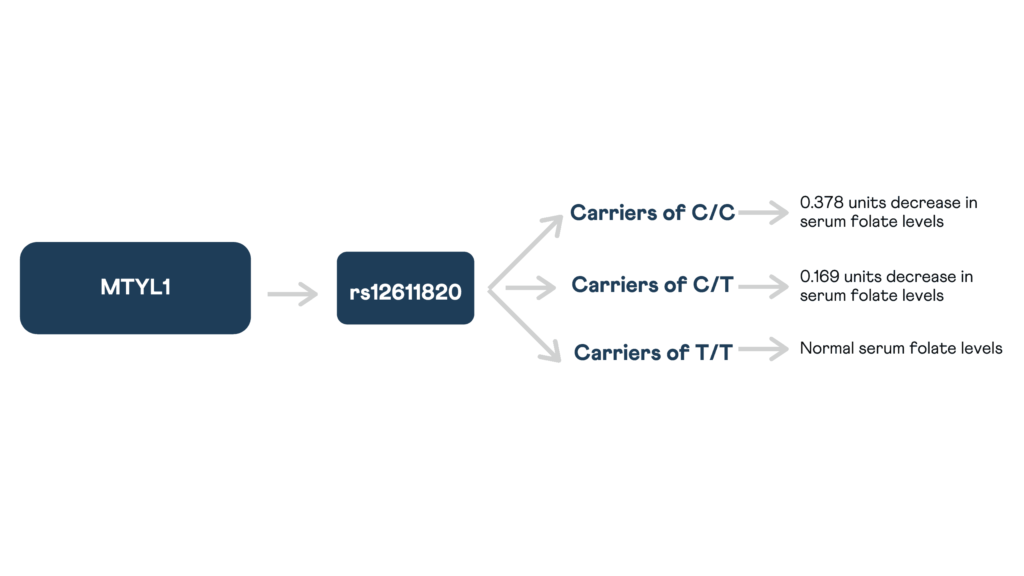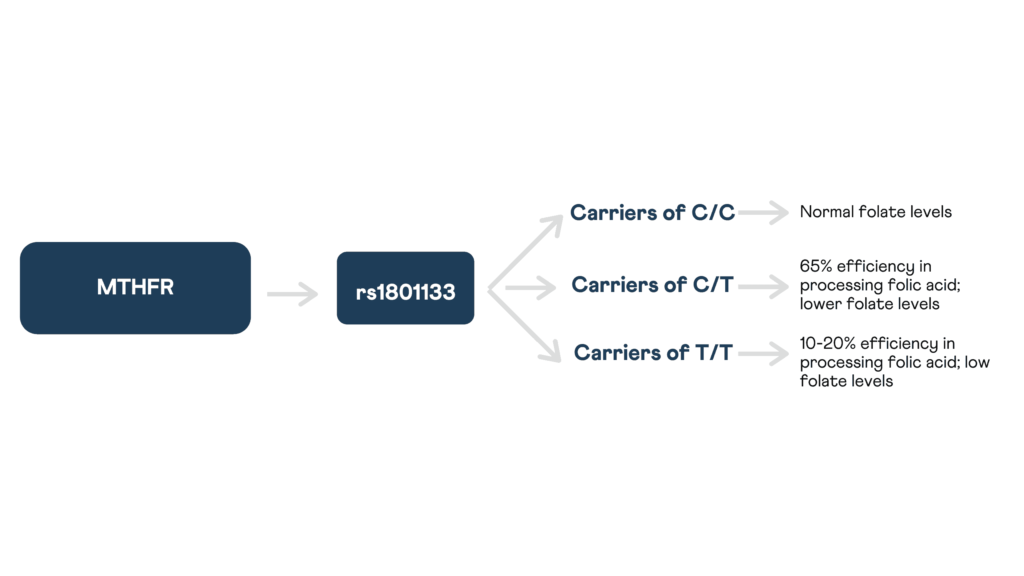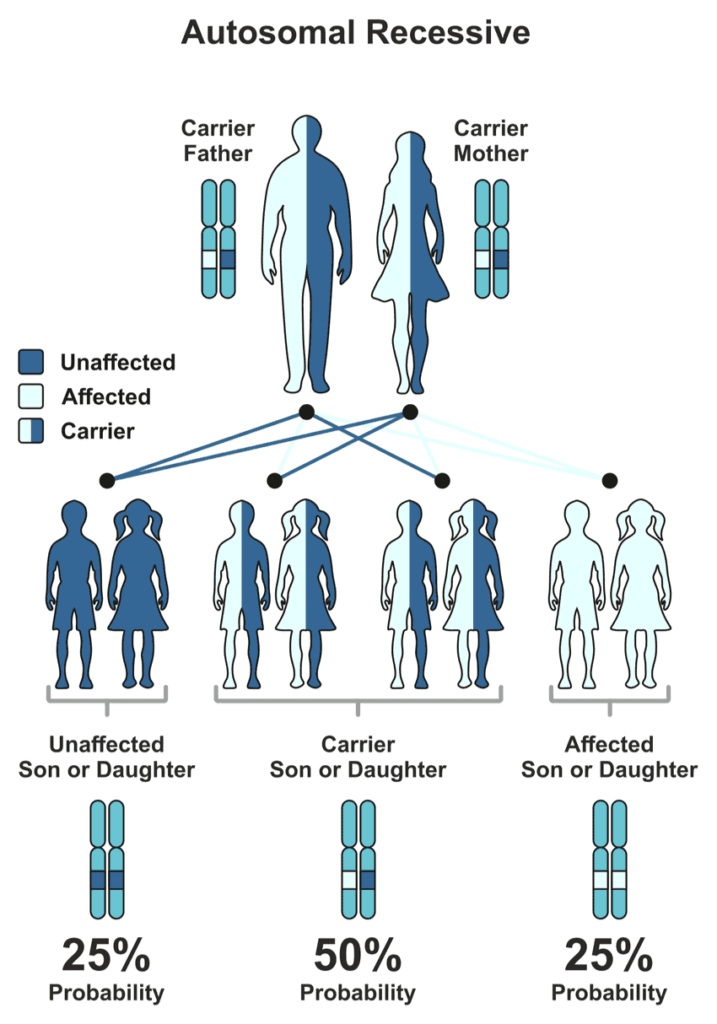Reports
Health
Wellness
Folate, also known as vitamin B9, is a water-soluble B vitamin. It is naturally found in many folate-containing foods like spinach, broccoli, avocados, and lentils.
Apart from natural sources, the synthetic form of folate, folic acid, is also sold as a supplement. This form is supposedly absorbed better by the body.
Lucy Wills, a researcher, was the first one to identify folate and its function, in 1931. She demonstrated that anemia in pregnant women could be prevented/reversed with brewer's yeast. In the late 1930s, folate was isolated from brewer's yeast.
It was first extracted from spinach in 1941 - the term "folic" is from the Latin word 'Folium', which means leaf.
Further, the crystalline form of folate was extracted in 1943, which was the basis of the synthesis of Aminopterin, a derivative of folic acid.
Aminopterin was the first-ever anticancer drug developed, and its clinical efficacy was proved in 1948.
Vitamin D and folate are linked by their disparate sensitivities to Ultra Violet Radiation (UVR). While UVR stimulates the production of Vitamin D in the skin, it degrades folate through oxidation.
The hypothesis suggests that skin pigmentation may have evolved to maintain a balance in the levels of these vitamins.
The increased pigmentation observed in high-UVR regions was attributed to the need for protecting folate levels, while the depigmentation is low-UVR regions was a result of facilitating adequate vitamin D levels.
The VDR gene provides instructions for making a protein called Vitamin D Receptor, which allows the body to take in vitamin D. The different variants of the VDR genes are present in different frequencies across populations.
For example, the common VDR variant Fok1 has a lower frequency in African populations compared to European/Asian populations, while the frequency of another variant, Cdx2, is highest in African populations and the lowest in Europeans.
The difference in the frequency of these alleles across different ethnic populations can be attributed to the different UV regimes.
Several relationships are reported between UVR and folate metabolism genes. Two main enzymes involved in folate metabolism, serine hydroxymethyltransferase (SHMT) and methylenetetrahydrofolate reductase (MTHFR), have been studied to be UVR responsive.
For example, in regions where there’s a higher exposure to UVR, the frequency of a thermolabile MTHFR variant, C677T, is less.
These findings collectively provide strong molecular support to the Vitamin D-Folate hypothesis and showcase the existence of interactions between UVR, skin type, and vitamin D and folate genes.
Typically, the body has around 10-30 mg of folic acid stored in the liver, and 5-15 ng/mL in the blood.
In order to understand the recommended dosage of folic acid, the following terms are important:
It is important to note that the bioavailability of folate depends on the source. Synthetic vitamin B9 (folic acid) is readily absorbed (about 85%) into the body, compared to folate from food sources (about 50%). Dietary Folate Equivalent (DFE) was developed to reflect the total amount of bioavailable folic acid.
1 mcg DFE = 1 mcg food folate = 0.6 mcg of fortified foods/supplements taken with foods = 0.5 mcg folic acid in the form of a supplement (taken on an empty stomach).
A healthy adult needs 400mcg DFE folate daily. Pregnant women need 600 mcg of folate per day to meet the requirements of the growing fetus as well.
MTYL1 gene is located on chromosome 2.
It codes for myelin transcription factor 1, which is expressed in the neuronal tissues.
This transcription factor converts postnatal human fibroblasts into induced neuronal cells, thus playing a big role in cognitive function.
A variant in this gene is linked with serum folate levels.
This gives an initial idea of an association between folate levels and depression and schizophrenia.
rs12611820
A variation in this gene, with a C genotype, is reported to be linked to serum folate levels. In a GWAS study conducted, a single copy of the C allele was seen to decrease the serum folate levels by 0.169 units.

The MTHFR gene is located on chromosome 1. It codes for an enzyme called methylenetetrahydrofolate reductase, which plays a role in processing amino acids. This enzyme is involved in a chemical reaction that processes folate to its primary form (5-methyl tetrahydrofolate) found in the blood.
This compound is necessary for the multistep process that converts homocysteine to methionine.
In the normal functioning of the body, there is a balance between homocysteine and folate levels. However, when this balance is disturbed, it leads to health effects.
Mutations in the MTHFR gene have been associated with high homocysteine and low folate levels, both of which are harmful to the body.
rs1801133The most-studied variant of the MTHFR gene is 677T←C (rs1801133) in exon 5. The 677T variant has been studied to be less effective in the conversion of 5,10-methylenetetrahydrofolate to 5-methyltetrahydrofolate.
Thus, the serum folate concentration is lower in individuals with the 677TT genotype than in those with 677CC or 677CT genotypes.

Inherited folate deficiency, also called Hereditary folate malabsorption, is a disorder that interferes with the body’s ability to absorb folates from food. Infants with this condition have normal folate levels at birth; however, they begin to show signs of folate deficiency within the first few months of life. Feeding difficulties, diarrhea, and failure to thrive are common signs observed in infants with inherited folate deficiency.
This condition is inherited in an autosomal recessive manner.
Now, for the expression of a recessive trait, both parents must pass on their recessive versions of traits.
A random process selects the gene to be passed down to the next generation.
In the case of autosomal recessive conditions, there is a 25% chance of occurrence.
If just one parent passes it on, the child will remain healthy but acts as a carrier of the gene.
Carriers could potentially pass it on to the coming generations.

Folate deficiency is usually a result of poor diet, alcoholism, and malabsorptive disorders. Hence the prevalence of isolated folate deficiency is pretty rare; other nutritional deficiencies mostly accompany it.
What Are The Signs And Symptoms Of Folate Deficiency
Causes of folate deficiency
Who’s at risk for folate inadequacy
It is rare to reach a toxicity level from consuming folate via natural food sources. An arbitrary upper limit for folic acid on a daily basis is 1000mcg.
Dangers of folate toxicity
Since vitamin B9 is water-soluble, it needs to be replenished in the body on a daily basis. There are a lot of sources of vitamin B9.
Folate is also available in the form of dietary supplements. Multivitamin supplements and B-complex tablets usually contain folic acid. These supplements are advised for individuals that have a mutation in the MTHFR gene.
It is recommended to take the active form of folic acid (L-methyl folate, or 5-MTHF). It is beneficial to have folic acid supplements daily to ensure optimal nutrient health for an individual.
Folate is an important vitamin that helps in cell replication, production of RBCs, and the maintenance of healthy cells in the body.
It is a water-soluble vitamin and should be included in the daily diet for a healthy individual.
There are vast implications if an individual has folate deficiency, with symptoms ranging from mouth sores to life-threatening anemia.
Pregnant women should also be wary of the amount of folic acid in their diet, as it can heavily impact the health of the fetus.
An individual can have inadequate folic levels because of an unbalanced diet, genetic variations, or other risk factors.
Folate deficient individuals can meet their requirements by adjusting their diet or taking supplements. When it comes to supplements, the dosage is an important factor.
Excess folate consumption can lead to folate toxicity the could result in a decline in cognition.
Thus, as always, it is recommended to consult a physician before starting any supplementation.
The Methyl Tetra Hydrofolate Reductase gene (MTHFR) is associated with the synthesis of the MTHFR enzyme, which converts folate obtained from the diet into an active form. The active folate is involved in the re-methylation of homocysteine to methionine. MTHFR gene variations determine how the body utilizes folate from the diet. People with the T variant of the gene are associated with lower levels of MTHFR enzyme which increases the risk for folate deficiency when there is a low intake of folate in the diet.
In a study conducted on people with major depressive disorder, people with the T variant with low folate intake were shown to be associated with an increased risk of elevated plasma homocysteine levels. Elevated levels of homocysteine are found to be associated with an increased risk for depression, bipolar disorder, neural tube defects, Alzheimer’s disease, and schizophrenia. Homocysteinemia is also associated with increased oxidative stress and DNA damage, triggering apoptosis and excitotoxicity.
In a meta-analysis, taking into account 50 research studies on the influence of MTHFR gene on neural tube defects, the presence of maternal T variant of the gene was associated with increased risk for neural tube defects among newborns.
People with the T variant of the gene are associated with increased risk for hypertension by 24-87% and CVD by 40%. Intake of sufficient amount of riboflavin lowered blood pressure among people with the T variant of the gene.
In a study conducted on the South Asian population, men with the T variant were significantly associated with male infertility.
In a meta-analysis with nearly 74,000 participants, people with the T variant of the gene were shown to be associated with an increased risk for breast cancer.
People with the T variant of the gene were shown to be associated with higher plasma homocysteine levels with an increased risk for rheumatoid arthritis. A similar study also showed an association between the T variant of the gene and an increased risk for rheumatoid arthritis.
| CHIP Version | MTHFR SNPs |
| 23andMe (Use your 23andme raw data to know your MTHFR Variant) | |
| v1 23andme | Present |
| v2 23andme | Present |
| v3 23andme | Present |
| v4 23andme | Present |
| V5 23andme (current chip) | Present |
| AncestryDNA (Use your ancestry DNA raw data to know your MTHFR Variant) | |
| v1 ancestry DNA | Present |
| V2 ancestry DNA (current chip) | Present |
| Family Tree DNA (Use your FTDNA raw data to know your MTHFR Variant) | |
| OmniExpress microarray chip | Present |
In a study conducted on the Eastern Indian population, people with the T variant of the gene were shown to be associated with vitamin B12 deficiency and hyperactivity and impulsiveness.
People with the T variant of the gene were associated with non-response to methotrexate in the treatment for rheumatoid arthritis.
| Genotype rs1801133 | Phenotype | Recommendation |
| TT | [Limitation] More likely to have lower MTHFR enzyme activity [Limitation] More likely to have hyperhomocysteinemia [Limitation] More likely to deliver babies with Neural tube Defects (Women) [Limitation] More Likely to have higher blood pressure and increased risk for cardiovascular disease [Limitation] More Likely to have rheumatoid arthritis [Limitation] More Likely to have ADHD [Limitation] More likely to be infertile (Male) [Limitation] Less likely to respond to Methotrexate (for treatment of rheumatoid arthritis) | Include at least 400 mcg of folate in the diet every day Folate-rich foods include romano beans, white beans, lentils, asparagus, okra, green leafy vegetables Include sufficient riboflavin in the diet to lower risk for hypertension. Riboflavin-rich foods include Mushroom, spinach, lamb, milk and natural yogurt |
| CT | Moderate level of MTHFR enzyme | Include recommended daily intake (RDI) of folate and riboflavin in the diet. |
| CT | [Advantage] More likely to have higher MTHFR enzyme [Advantage] Less likely to have hyperhomocysteinemia [Advantage] Less likely to deliver babies with Neural tube Defects (Women) [Advantage] Less Likely to have higher blood pressure and increased risk for cardiovascular disease [Advantage] Less Likely to have rheumatoid arthritis [Advantage] Less Likely to have ADHD [Advantage] Less likely to be infertile (Male) [Advantage] More likely to respond to Methotrexate (for treatment of rheumatoid arthritis) | Include recommended daily intake (RDI) of folate and riboflavin in the diet. |
“Nutrigenetics, fitness genetics, health genetics are all nascent but rapidly growing areas within human genetics. The information provided herein is based on preliminary scientific studies and it is to be read and understood in that context.”
[idea]Folate (vitamin B9, folic acid) is essential for life-sustaining processes of DNA synthesis, replication, and repair and they are naturally present in common foods such as black eyed peas, liver, asparagus, beets, brussels sprouts, and spinach. Folate levels have been associated with birth defects, cardiovascular disease , and many other important healthcare issues . Individuals differ in their ability to metabolise folate, depending on the type of MTHFR gene that they carry. This article will tell you how you can protect your body and mitigate the influence of your genes by making proper food choices.[/idea]
[hr height="30" style="default" line="default" themecolor="1"]
Methyl folate is essential for the proper function of almost all of the body’s systems and it is involved in the conversion of an amino acid homocysteine into methionine. When you eat foods containing folate, MTHFR ( Methylene Tetra Hydrofolate Reductase) enzyme in your body converts it into methylfolate, an active form of folate. MTHFR enzyme is produced by the MTHFR gene. If you have two “normal” copies of this gene, then you produce fully functioning enzyme, if you have one “normal” copy, the enzyme function is reduced and if you have no “normal” copies, then the function is reduced even further.
If you carry a type “TT” (abnormal) of the MTHFR gene, it leads to lower levels of folate in the blood & reduced enzyme activity, results in elevated levels of homocysteine in the body . Elevated homocysteine level is an independent risk factor of cardiovascular diseases among Indians.
Individuals who carry one copy of the abnormal T-type of the gene can still metabolize folate normally when compared to individuals carrying two copies of the abnormal TT-type of the gene and they are at a higher risk for (hyperhomocysteinemia (elevated levels of homocysteine) in their body.
[hr height="30" style="default" line="default" themecolor="1"]
|
The American Heart Association advocates a supplement regimen of 400 μg of folic acid, 2 mg of vitamin B6, and 6 μg of vitamin B12, if an initial trial of a folate-rich diet is not successful in adequately lowering homocysteine concentrations.
In addition, get your homocysteine levels measured. High homocysteine levels indicate that you may have a methylation issue or folate deficiency.
Want to know more about MTHFR gene, Xcode’s nutrigenetics test can tell you what versions of the MTHFR gene you have in your DNA. You can also learn about how your genes may influence other traits, including your risk for certain diseases. You can write to us at info@xcode.in.
